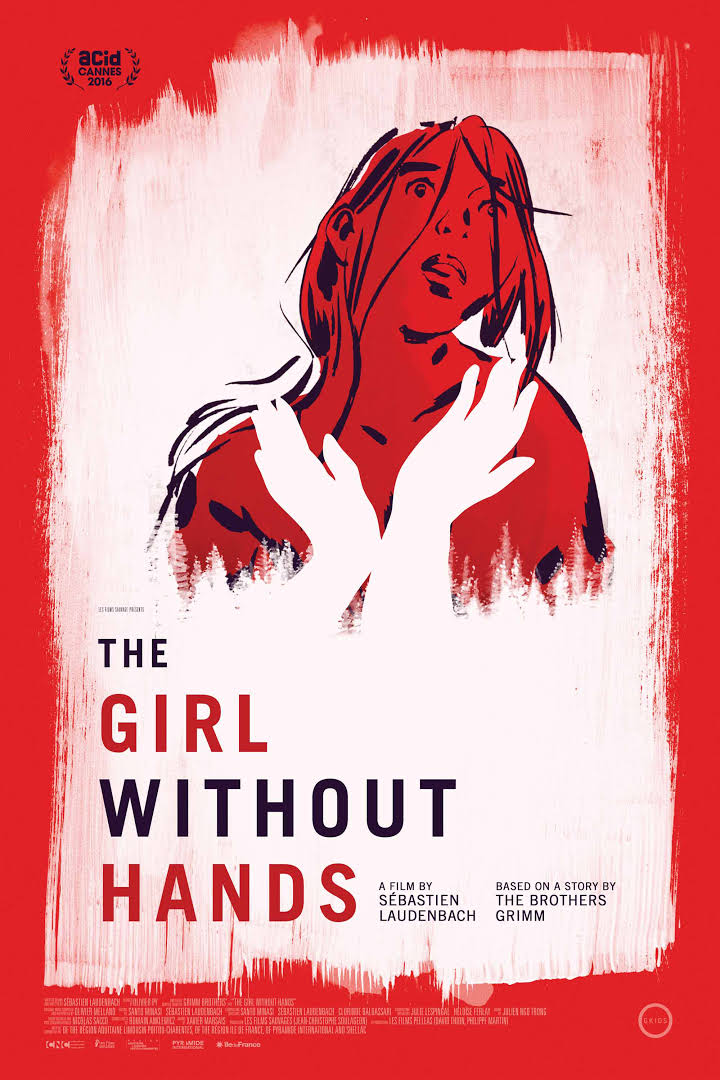The 2017 Animated Contenders: "The Girl Without Hands"
 Friday, November 24, 2017 at 5:33PM
Friday, November 24, 2017 at 5:33PM by Tim Brayton
 Last week, we took a look at Loving Vincent, a stunningly gorgeous animated feature taking its aesthetic cues from traditional fine arts; and this week, we're doing the same thing. Though the style in the French The Girl Without Hands is quite a long way from the rich oil portraits of Loving Vincent. Now, the inspiration is (or anyway, appears to be) Chinese ink wash painting, the art of sketching out characters and settings in a few swift, bold brush strokes with strongly-colored ink. The results deserve the same praise: this is, visually, one of the most distinctive, special, and unusual piece of cinema released this year.
Last week, we took a look at Loving Vincent, a stunningly gorgeous animated feature taking its aesthetic cues from traditional fine arts; and this week, we're doing the same thing. Though the style in the French The Girl Without Hands is quite a long way from the rich oil portraits of Loving Vincent. Now, the inspiration is (or anyway, appears to be) Chinese ink wash painting, the art of sketching out characters and settings in a few swift, bold brush strokes with strongly-colored ink. The results deserve the same praise: this is, visually, one of the most distinctive, special, and unusual piece of cinema released this year.
This time around, the film has a narrative that can stand up to its style. The Girl Without Hands is a fairly straightforward adaptation of the Grimm fairy tale, about a young woman (voiced by Anaïs Demoustier) whose miller father (Olivier Broche) unwittingly promises her to the Devil (Philippe Laudenbach) in exchange for a river of endless gold...
When her goodness and purity proves to be too much for the Devil to possess, he orders the miller to cut off the young woman's hands. Still unbroken, she escapes into the world, where she is found by a sympathetic prince (Jérémie Elkaïm), who marries her and gives her a pair of golden hands, though there is still plenty of bleakness and suffering to get through before the film's swift 76 minutes are all up.

The film's director and writer, Sébastien Laudenbach, makes little effort to modernize any of this, other than perhaps mildly stressing the proto-feminist elements of the story more than would be inherently part of the source material. Otherwise, without exception, this retains the primitive simplicity of folklore, giving its characters strong, nuance-free personalties, and taking place in an indefinite world that can't be defined more specifically than "Europe, between 500 and 1700 AD".
In keeping with that essentialism and purity, the film's style evokes space more than clearly lays out it, and presents characters as impressions of lines and movements just as often as it gives the stable, well-designed features. Every character, every time we see them, takes the form of an outline drawn in a single uniform shade of digital ink; often, they can be seen over patches of solid colors that fade in and out from the background without the least pretense to matching the outline perfectly.

You can see a little bit of this in stills, though it's quite a bit more arresting in movement, when the fluidity and lack of definition in the characters emerges much more strongly. It's beautifully minimalistic in its own right, and has the undeniable appeal of the truly idiosyncratic; while individual scenes and short films have been done in a style derived from Chinese ink wash art (the musical number "A Girl Worth Fighting For" from Disney's Mulan is probably the most prominent example), The Girl Without Hands is up to something more distinctive than just animating a traditional art form.
If nothing else, the bright colors and perfect clarity of the digital production turns this into something wholly its own. You could never mistake these images for actual paintings: the characteristic blurring of the edge of lines as the ink saturates the paper isn't here, though the artists have put some effort into creating frayed edges on their digital brush strokes. This is more like Studio Ghibli's 2014 Oscar nominee The Tale of the Princess Kaguya, marrying the best traits of traditional art (the delicacy of line work and the almost tangible presence of the artists' hands; the stimulating unreality of seeing recognizable objects transformed into splashes of pure style), with the strengths of digital image-making (clarity and crispness, shapes that are easy to manipulate without losing their spatial integrity) in the creation of a work of animation that's neither traditional nor modern, but some exciting mixture of the two.

A good description for the film's narrative ethos as well as its style, and the result is one of the most satisfying experiments in what appears like style-for-style's sake that 2017 has witnessed. This is the kind of transporting art that animation is uniquely capable of creating, and in that respect at least, The Girl Without Hands is maybe the most exciting animated film of the year.
Reviews of Eligible Animated Contenders:
In this Corner of the World (Japan) reviewed by Tim Brayton
The Big Bad Fox (France) reviewed by Tim Brayton
Coco (US) reviewed by Jorge Molina
The Breadwinner (Ireland/Canada/Luxembourg) reviewed by Nathaniel
The Emoji Movie (US) reviewed by Sean Donovan
The Boss Baby (US) reviewed by Nathaniel R
Loving Vincent (UK/Poland) reviewed by Tim Brayton
Smurfs: The Lost Village (US) reviewed by Tim Brayton
Birdboy: The Forgotten Children (US) reviewed by Tim Brayton



Reader Comments (2)
Would love to see this!
Really really liked it when I saw it back in July. Animation that borders on the abstract.